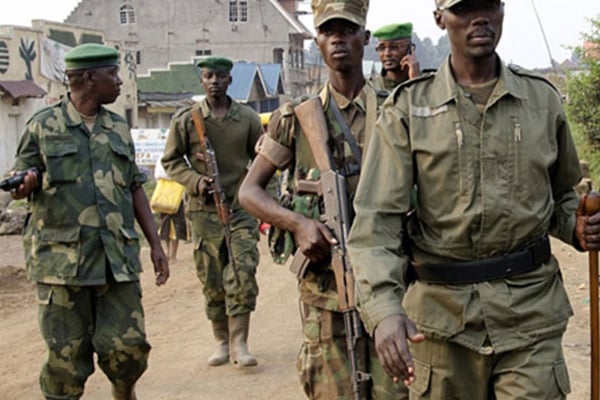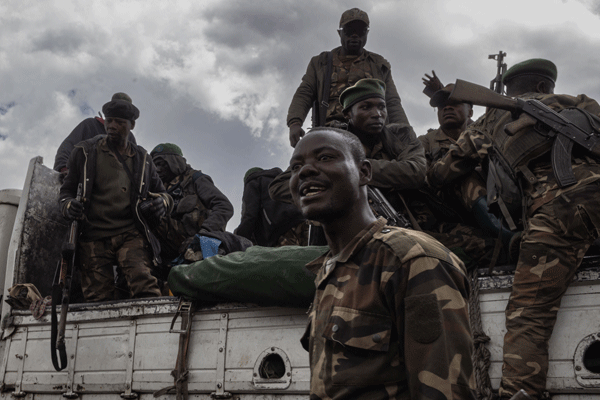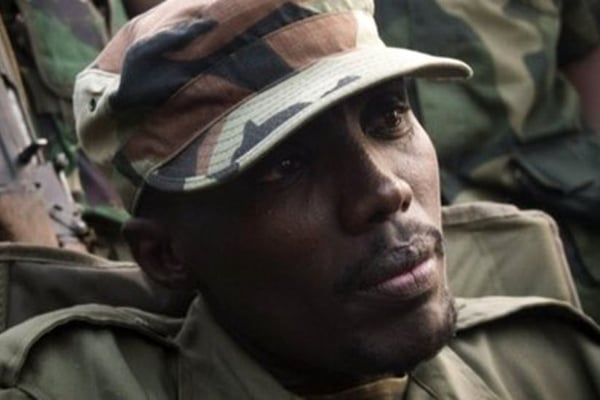Prime
Fog of war thickens in troubled DR Congo

M23 commander Col Sultani Makenga (right) and his body guards tour Bunagana, a town near the Ugandan border, on July 8, 2012. PHOTOS | AFP
What you need to know:
- The Eastern DR Congo has more than 150 rebel militias who are often seen carrying AK-47 rifles and festooned with belts of cartridges roaming the vast green jungles. They have exploited the Kinshasa government weaknesses such as poverty, structural intrastate violence and unequitable distribution of wealth, Emmanuel Mutaizibwa writes.
The East African Community (EAC) regional force has begun deploying boots on the ground across one of the most volatile pockets on earth in the neighbouring state of the eastern DR Congo where millions have been slaughtered and displaced, and thousands raped in the last decades.
Burundi was the first to send troops into South Kivu in August while Kenyan Special Forces — undertaking a reconnaissance mission, have been deployed at Ishasha which lies at the DRC-Kanungu District border.
The plank of this deployment is two-pronged as it seeks a peaceful settlement with the armed groups who will be demobilised and integrated into the national army. If this option fails, the regional force will then rely on its military capabilities to annihilate these armed groups.
Kenya, which occupies a neutral position— has been given the overall duty to coordinate the regional forces while Uganda has been assigned the logistics role as Rwanda, whose troops are restricted from entering the territory of its implacable adversary— has been handed the intelligence role.
Questions abound about the interoperability of the different armies whose geo-political interests often clash.
How will the East African Community force be integrated into other fighting forces, including the lame duck United Nations Organisation mission into the DRC (MONUSCO) and the Force Intervention Brigade (FIB) led by SADC, and foreign armies who are illegally deployed into the DRC?
The Eastern DR Congo has more than 150 rebel militias who are often seen carrying AK-47 rifles and festooned with belts of cartridges roaming the vast green jungles.
They have exploited the Kinshasa government weaknesses such as poverty, structural intrastate violence and unequitable distribution of wealth, among others. Eastern DR Congo also has private armies from Israel, Russia and Angola.
Some of these militias pay allegiance to the Kinshasa government while others are in cahoots with regional rebel groups and fund their enterprise by imposing taxes on the locals and exploiting the wealth buried in the mineral-rich bowels of Kivu.
Prof Philip Kasaija, a regional security expert and academic in international affairs, said: “There is a mandate that has been given to the EAC force. The assumption is that this force as the concept of the operation is supposed to be, is a cohesive unit, which takes direction from the Secretary General of the EAC individual interests. The main task is meant to deal with negative forces, pretty much like the African Transition Mission in Somalia (ATMIS).”
But Kasaija fears that the deployment could be a knee-jerk reaction to the M23 rebel group’s re-emergence. “This may complicate things further, the terrain is very fluid, more than 130 rebel groups both local and international in eastern DRC. It [deployment] requires more thinking.”
He opines that the region has previously authored a number of security blueprints and frameworks to stabilise DRC.
“The more the DRC remains neglected, the more it becomes more complicated, the alternative is that all the foreign forces leave and capacitate the Armed Forces of the Democratic Republic of Congo (FADRC) to deal with the problem.”
The process that culminated in the signing of the Peace, Security and Cooperation Framework for the Democratic Republic of the Congo and the region (PSC Framework) on February 24, 2013 reflected a shared vision of the leaders of the region and the international community to address the underlying causes of recurrent violent conflict in eastern DRC.
Past efforts to neutralise armed groups that operate in eastern DRC did not achieve the desired results, thus threatening the peace, security and development of the entire region.
But the M23, a rebel faction largely consisting of Tusti fighters sprang to life in 2021. It has since captured swathes of territory in North Kivu province, including the strategic town of Bunagana on the Ugandan border in June.
The group’s resurgence has threatened the stability of the Great Lakes with the DRC accusing its neighbour Rwanda of backing the militia.
Yesterday, the rebels seized control of two major towns in eastern DRC as they continued to expand their territory as thousands fled fierce fighting.

UPDF soldiers display guns and goats that were reportedly recovered from an ADF camp in eastern DR Congo in February. Photo courtesy / ministry of defence
The Kinshasa government through the High Defence Council has since then ordered the Kigali government envoy, Vincent Karega, to leave the country within 48 hours after M23 captured Kiwanja and Rutshuru, near the Rwanda border and 70km from the regional capital of Goma in North Kivu province.
The expulsion could further escalate the diplomatic row between Kigali and Kinshasa.
It also comes at the time the UN peacekeeping mission warned of retaliatory attacks if there was further aggression against its bases after four of its peacekeepers were wounded recently.
A 131-page report by United Nations Security Council experts found Rwanda launched military interventions inside Congolese territory since November 2021, providing “troop reinforcements” for specific M23 operations, “in particular when these aimed at seizing strategic towns and areas”.
Ms Yolande Makolo, the Rwanda government spokesperson, said in a statement the government would not comment on an “unpublished and unvalidated report.” She said an earlier report by the experts’ group in June “contained none of these false allegations”.
On October 20, three United States Senators authored a letter to US Secretary of State Antony Blinken and the Secretary of the Treasury, Ms Janet Yellen, seeking sanctions against those giving material and financial support to M23.
The letter partly reads: “Credible reports by established human rights organisations indicate that M23 has a regular supply of modern arms and munitions that allow its members to regularly strike targets over long distances and execute precision fires against aircraft, suggesting direct state-sponsored support. Given the years and degree of human suffering in eastern Congo, we ask for an update on ongoing enforcement of US sanctions against M23 as required by public law.”
It further reads: “Since the beginning of this year, more than 700,000 people have been forced to flee their homes, with many civilian deaths. Human rights groups have tracked cases of torture, rape and imprisoned civilians forcibly made to engage in cannibalism with their murdered fellow prisoners. These horrific reports come as M23 displays offensive capabilities more in line with a conventional army.”
These M23 rebel attacks bring to the fore a complex terrain — the ever-changing frontlines, fickle alliances, proxy militias and regional interests in this restive part of the country, which has turned Kivu into a tinderbox.
The M23 rebellion sprouted in April 2012 in Rutshuru, North Kivu when hundreds of largely ethnic Tutsi soldiers of FARDC, the national army, mutinied over appalling living conditions and poor pay.
Most of the mutineers had been members of the National Congress for the Defence of the People (CNDP) another armed group that in 2009 signed a deal with the government, which the dissidents felt Kinshasa had not fully implemented. M23 is named after the date the agreement was signed.
On February 24, 2013, leaders of 11 African nations signed an agreement designed to bring peace to the eastern region of the DR Congo. On March18, 2013, M23 leader Bosco Ntaganda whose cruelty and violence earned him a nickname Terminator turned himself in to the US embassy in Kigali, Rwanda, where he requested transfer to the International Criminal Court in The Hague.
Although the reasons for his surrender are unknown, it was speculated that he was either pressured to do so by Rwanda or feared infighting within the M23 movement and its military leader Sultani Makenga, which had recently forced Ntaganda’s forces to flee the DRC into Rwanda.
Ntaganda was in 2019 sentenced by ICC to 30 years in prison for war crimes and crimes against humanity.
Although some M23 elements surrendered in the DRC and some retreated to Rwanda, on November 5, the bulk of the remaining force under Makenga crossed into Uganda.
The CEO of Atrocities Watch-Africa, Dismas Nkunda told Daily Monitor: “It is going to be a difficult terrain as some of the contributing troops already have a presence. The only countries with a mutual stance are Kenya and Tanzania, Kenya should be an important arbiter.”
Nkunda, who previously worked as a journalist, said it was such a coincidence that M23 commenced attacks barely after the UPDF began pursuing the ADF.
“Monusco says they have never seen a well-armed and organised and efficient force like M23. We can’t wish this away. Rwanda can’t allow Uganda’s presence in the DRC without their presence.”
Mr Timothy Kalyegira, a researcher and journalist, told Daily Monitor in April that since the Rwandan Patriotic Front (RPF) came to power in Rwanda 1994, “It has been acutely aware of its vulnerability from the DRC. On and off tensions with Uganda since the late 1990s have made DR Congo that much more important to Rwanda, especially in recent years when Rwanda accused Uganda of supporting the anti-Kigali RNC.”
Kigali had also drawn a line in the sand warning that North-Kivu should be a no-go area for the UPDF.
Mr Fredrick Kisekka Ntale, a political scientist, said the deployment is an attempt of creating an institutional framework to pursue interests of peace in the East African Community (EAC).
“I think in one way, the EAC force in the context of the EAC community is trying to make itself relevant. In most simplistic terms, it’s trying to copy what the Economic Community of West African States Monitoring Group [ECOMOG] is doing, meaning that for us to have a reliable regional economic community, we must also foster, peace and security within the community.”
Ntale proffers that the deployment seeks to lessen the burden on western powers to solve the problems of DRC by creating a regional stabilisation force.

More Congolese refugees cross into Kisoro District through Bunagana border post last Sunday. Since the beginning of this year, more than 700,000 people have been forced to flee their homes. PHOTO / ROBERT MUHEREZA
Whereas he acknowledges hostilities and mutual suspicion amongst partner states, he believes that the new framework offers an environment to resolve long-standing disputes.
“That could be the reason why the EAC force is going there, to limit the extent of one country being labelled as the spoiler causing recurrent violence,” he argued.
However, he fears that the regional force may use the veil of peace enforcement to plunder DRC resources.
In December 2021, the UPDF deployed its troops inside the DRC after inking a deal with Kinshasa allowing the troops to hunt down the Islamist Allied Democratic Forces (ADF) rebels accused of using the neighbouring state as a sanctuary to sow mayhem in Uganda.
At the commencement of the deployment, a political historian, Prof Ogenga Otunnu opined: “The primary objective may have little to do with pursuing terrorism but rather an attempt by the Ugandan government to try and salvage its national legitimacy by making itself the kingmaker in a troubled region.’
He added: “In politics at times, you find the most plausible explanation that your citizens and international community will buy and that’s the one you advance. In other words, you may have different motives coming together, one could be pursuing rebels, shoring up political legitimacy of government, especially after a hotly contested election which the western world pronounced on itself as not having been free and fair and not accurate.”
The UPDF’s deployment has since placed other regional players on alert. Rwanda, which has been having a long-standing dispute with Uganda and Burundi continues to closely monitor events in North and South Kivu, where it claimed in the past that the two countries were seeking to shore up rebel fighters to attack the Kigali government.
In turn, Kampala and Bujumbura have in the past claimed that Rwanda is supporting armed groups against these governments.
Daily Monitor newspaper has seen a classified document, which indicates that initially DR Congo wanted to invite the armies of three countries into the eastern part of the country. It is not clear yet why this plan was shelved.
“The DR Congo calls for reinforcements from the armies of neighbouring countries, its partners,” reads the document signed by the Congolese Army chief of staff, Gen Célestin Mbala Munsense, who speaks of an integrated general staff. The armies, according to the shelved blueprint, would then conduct special operations aimed at decimating ‘all the active or dormant foreign and Congolese armed groups to secure suburbs and roads that are vital for the country.’
“The operations shall begin on November 15, 2019 by the installation of foreign armies and end in mid-May next year with the stabilisation of the region and the withdrawal of partner contingents. The four countries will assist the DRC armed forces in exchange for information, intelligence support, support for special force units, and control of the land and lake border,” the document read.
Otunnu said: “The biggest fear at the time was not Uganda, Rwanda, Burundi going to DR Congo. It was the fear that if all the three countries’ armies were deployed, it potentially could develop into a full-blown war.”
For now, the UPDF remains holed up in eastern DRC under the command of the recently appointed Maj Gen Dick Olum, a military officer with consummate skills at the battle front. It is not clear yet how the Ugandan army plans to dovetail its Operation Shujaa objectives with those of the East African community regional force.
How M23 was formed
The M23 rebellion sprouted in April 2012 in Rutshuru, North Kivu when hundreds of largely ethnic Tutsi soldiers of FARDC, the national army, mutinied over appalling living conditions and poor pay.
Most of the mutineers had been members of the National Congress for the Defence of the People (CNDP) another armed group that in 2009 signed a deal with the government, which the dissidents felt Kinshasa had not fully implemented. M23 is named after the date the agreement was signed.




